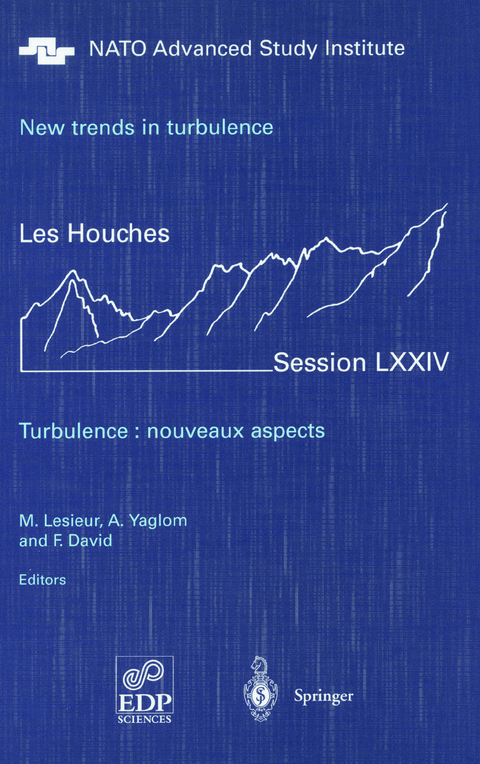
New trends in turbulence. Turbulence: nouveaux aspects
Les Houches Session LXXIV 31 July - 1 September 2000
Seiten
2010
|
1. Softcover reprint of hardcover 1st ed. 2001
Springer Berlin (Verlag)
978-3-642-07695-4 (ISBN)
Springer Berlin (Verlag)
978-3-642-07695-4 (ISBN)
Following a longstanding tradition of the Les Houches Summer Schools, this book uses a pedagogically presented and accessible style to treat 2D and 3D turbulence from the experimental, theoretical and computational points of view.
The phenomenon of turbulence in fluid mechanics has been known for many centuries. Indeed, it was for instance discussed by the Latin poet Lucretius who described in "de natura rerum" how a small perturbation ("clinamen") could be at the origin of the development of a turbulent order in an initially laminar river made of randomly agitated atoms. More recently, Leonardo da Vinci drew vortices. Analogous vortices were sketched by the Japonese school of artists called Utagawa in the 19th century, which certainly influenced van Gogh in "The Starry Night". However, and notwithstanding decisive contributions made by Benard, Reynolds, Prandtl, von Karman, Richardson and Kolmogorov, the problem is still wide open: there is no exact derivation of the famous so called Kolmogorov k 5'3 cascade towards small scales, nor of the value of the transitional Reynolds number for turbulence in a pipe. Besides these fundamental aspects, turbulence is associated with essential practical questions in hydraulics, aerodynamics (drag reduction for cars, trains and planes), combustion (improvement of engine efficiency and pollution reduction), acoustics (the reduction of turbulence induced noise is an essential issue for plane reactors), environmental and climate studies (remember the huge damage caused by severe storms in Europe at the end of 1999), and astrophysics (Jupiter's Great Red Spot and solar granulation are manifestations of turbulence). Therefore, there is an urgent need to develop models that allow us to predict and control turbulence effects.
The phenomenon of turbulence in fluid mechanics has been known for many centuries. Indeed, it was for instance discussed by the Latin poet Lucretius who described in "de natura rerum" how a small perturbation ("clinamen") could be at the origin of the development of a turbulent order in an initially laminar river made of randomly agitated atoms. More recently, Leonardo da Vinci drew vortices. Analogous vortices were sketched by the Japonese school of artists called Utagawa in the 19th century, which certainly influenced van Gogh in "The Starry Night". However, and notwithstanding decisive contributions made by Benard, Reynolds, Prandtl, von Karman, Richardson and Kolmogorov, the problem is still wide open: there is no exact derivation of the famous so called Kolmogorov k 5'3 cascade towards small scales, nor of the value of the transitional Reynolds number for turbulence in a pipe. Besides these fundamental aspects, turbulence is associated with essential practical questions in hydraulics, aerodynamics (drag reduction for cars, trains and planes), combustion (improvement of engine efficiency and pollution reduction), acoustics (the reduction of turbulence induced noise is an essential issue for plane reactors), environmental and climate studies (remember the huge damage caused by severe storms in Europe at the end of 1999), and astrophysics (Jupiter's Great Red Spot and solar granulation are manifestations of turbulence). Therefore, there is an urgent need to develop models that allow us to predict and control turbulence effects.
The Century of Turbulence Theory: The Main Achievements and Unsolved Problems.- Measures of Anisotropy and the Universal Properties of Turbulence.- Large-Eddy Simulations of Turbulence.- Statistical Turbulence Modelling for the Computation of Physically Complex Flows.- Computational Aeroacoustics.- The Topology of Turbulence.- Burgulence.- Two-Dimensional Turbulence.- Analysing and Computing Turbulent Flows Using Wavelets.- Lagrangian Description of Turbulence.
| Erscheint lt. Verlag | 15.12.2010 |
|---|---|
| Reihe/Serie | Les Houches - Ecole d'Ete de Physique Theorique |
| Zusatzinfo | XXXVII, 554 p. |
| Verlagsort | Berlin |
| Sprache | englisch |
| Maße | 155 x 235 mm |
| Gewicht | 884 g |
| Themenwelt | Mathematik / Informatik ► Mathematik ► Analysis |
| Naturwissenschaften ► Physik / Astronomie ► Mechanik | |
| Schlagworte | Aeroacoustics • Burger's Equation • convection • Fluid Dynamics • Large-Eddy Simulations • Mixing • Modeling • Rotating Flows • Simulation • Turbulence • Wavelet • Wavelet Techniques |
| ISBN-10 | 3-642-07695-5 / 3642076955 |
| ISBN-13 | 978-3-642-07695-4 / 9783642076954 |
| Zustand | Neuware |
| Haben Sie eine Frage zum Produkt? |
Mehr entdecken
aus dem Bereich
aus dem Bereich
Buch | Softcover (2024)
De Gruyter Oldenbourg (Verlag)
59,95 €


